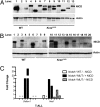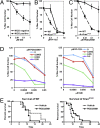Mutant Ikzf1, KrasG12D, and Notch1 cooperate in T lineage leukemogenesis and modulate responses to targeted agents
- PMID: 20194733
- PMCID: PMC2841878
- DOI: 10.1073/pnas.1001064107
Mutant Ikzf1, KrasG12D, and Notch1 cooperate in T lineage leukemogenesis and modulate responses to targeted agents
Abstract
Mice that accurately model the genetic diversity found in human cancer are valuable tools for interrogating disease mechanisms and investigating novel therapeutic strategies. We performed insertional mutagenesis with the MOL4070LTR retrovirus in Mx1-Cre, Kras(G12D) mice and generated a large cohort of T lineage acute lymphoblastic leukemias (T-ALLs). Molecular analysis infers that retroviral integration within Ikzf1 is an early event in leukemogenesis that precedes Kras(G12D) expression and later acquisition of somatic Notch1 mutations. Importantly, biochemical analysis uncovered unexpected heterogeneity, which suggests that Ras signaling networks are remodeled during multistep tumorigenesis. We tested tumor-derived cell lines to identify biomarkers of therapeutic response to targeted inhibitors. Whereas all T-ALLs tested were sensitive to a dual-specificity phosphoinosityl 3-kinase/mammalian target of rapamycin inhibitor, biochemical evidence of Notch1 activation correlated with sensitivity to gamma-secretase inhibition. In addition, Kras(G12D) T-ALLs were more responsive to a MAP/ERK kinase inhibitor in vitro and in vivo. Together, these studies identify a genetic pathway involving Ikzf1, Kras(G12D), and Notch1 in T lineage leukemogenesis, reveal unexpected diversity in Ras-regulated signaling networks, and define biomarkers of drug responses that may inform treatment strategies.
Conflict of interest statement
The authors declare no conflict of interest.
Figures





Similar articles
-
Loss of oncogenic Notch1 with resistance to a PI3K inhibitor in T-cell leukaemia.Nature. 2014 Sep 25;513(7519):512-6. doi: 10.1038/nature13495. Epub 2014 Jul 20. Nature. 2014. PMID: 25043004 Free PMC article.
-
Notch1 gene mutations target KRAS G12D-expressing CD8+ cells and contribute to their leukemogenic transformation.J Biol Chem. 2013 Jun 21;288(25):18219-27. doi: 10.1074/jbc.M113.475376. Epub 2013 May 14. J Biol Chem. 2013. PMID: 23673656 Free PMC article.
-
Wild-type KRAS inhibits oncogenic KRAS-induced T-ALL in mice.Leukemia. 2015 May;29(5):1032-40. doi: 10.1038/leu.2014.315. Epub 2014 Nov 5. Leukemia. 2015. PMID: 25371176
-
New insights into Notch1 regulation of the PI3K-AKT-mTOR1 signaling axis: targeted therapy of γ-secretase inhibitor resistant T-cell acute lymphoblastic leukemia.Cell Signal. 2014 Jan;26(1):149-61. doi: 10.1016/j.cellsig.2013.09.021. Epub 2013 Oct 16. Cell Signal. 2014. PMID: 24140475 Review.
-
The relevance of PTEN-AKT in relation to NOTCH1-directed treatment strategies in T-cell acute lymphoblastic leukemia.Haematologica. 2016 Sep;101(9):1010-7. doi: 10.3324/haematol.2016.146381. Haematologica. 2016. PMID: 27582570 Free PMC article. Review.
Cited by
-
Loss of glucocorticoid receptor expression mediates in vivo dexamethasone resistance in T-cell acute lymphoblastic leukemia.Leukemia. 2020 Aug;34(8):2025-2037. doi: 10.1038/s41375-020-0748-6. Epub 2020 Feb 17. Leukemia. 2020. PMID: 32066867 Free PMC article.
-
A cooperative microRNA-tumor suppressor gene network in acute T-cell lymphoblastic leukemia (T-ALL).Nat Genet. 2011 Jun 5;43(7):673-8. doi: 10.1038/ng.858. Nat Genet. 2011. PMID: 21642990 Free PMC article.
-
High-Complexity shRNA Libraries and PI3 Kinase Inhibition in Cancer: High-Fidelity Synthetic Lethality Predictions.Cell Rep. 2019 Apr 9;27(2):631-647.e5. doi: 10.1016/j.celrep.2019.03.045. Cell Rep. 2019. PMID: 30970263 Free PMC article.
-
Deletion-based mechanisms of Notch1 activation in T-ALL: key roles for RAG recombinase and a conserved internal translational start site in Notch1.Blood. 2010 Dec 16;116(25):5455-64. doi: 10.1182/blood-2010-05-286328. Epub 2010 Sep 17. Blood. 2010. PMID: 20852131 Free PMC article.
-
Challenges and advances in mouse modeling for human pancreatic tumorigenesis and metastasis.Cancer Metastasis Rev. 2013 Jun;32(1-2):83-107. doi: 10.1007/s10555-012-9408-2. Cancer Metastasis Rev. 2013. PMID: 23114842 Free PMC article. Review.
References
-
- Pui CH, Relling MV, Downing JR. Acute lymphoblastic leukemia. N Engl J Med. 2004;350:1535–1548. - PubMed
-
- Pui CH, Evans WE. Treatment of acute lymphoblastic leukemia. N Engl J Med. 2006;354:166–178. - PubMed
-
- Bhatia S, Sklar C. Second cancers in survivors of childhood cancer. Nat Rev Cancer. 2002;2:124–132. - PubMed
-
- Armstrong SA, Look AT. Molecular genetics of acute lymphoblastic leukemia. J Clin Oncol. 2005;23:6306–6315. - PubMed
Publication types
MeSH terms
Substances
Grants and funding
LinkOut - more resources
Full Text Sources
Other Literature Sources
Molecular Biology Databases
Miscellaneous

